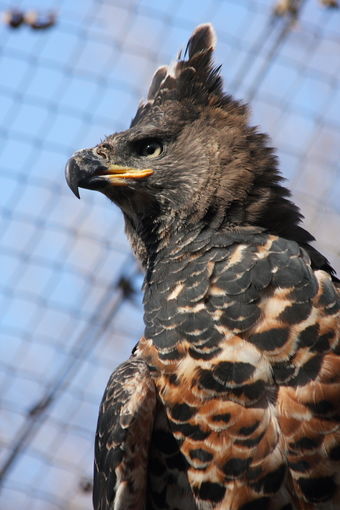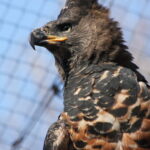The Crowned Eagle (Stephanoaetus coronatus) is the most powerful raptor in sub-Saharan Africa, known for its striking plumage and powerful hunting abilities. Adults have a dark to rufous-tinged brown crown with a prominent, black-tipped double crest, giving them a somewhat triangular appearance. Their upperparts are blackish brown-grey, while the belly and breast are white with blackish bars and blotches, variably marked with cream or rich buff-rufous coloration. The wing primaries are white at the base, broadly tipped with black and crossed by two black bars, and the tail is black with brownish-grey bands.
Crowned Eagle: The Apex Predator
Crowned Eagles are highly vocal, with males performing an elaborate rise-and-fall display over the forest canopy, often during the breeding season and as territorial displays. These displays consist of steep dives and ascents, with a few wing-flaps at the top of each climb and descending circles and figures of eight. The male is noisy during this display, uttering a shrill kewee-kewee-kewee while throwing his head back. The adult female may also perform independent display flights, uttering a lower kooee-kooee-kooee. Pairs also perform visually striking mutual displays, sometimes arising from the first type or when the pairs come together after a brief absence.
Crowned Eagles are carnivores and most of their diet consists of mammals, with small ungulates such as duikers and chevrotains being their primary prey. They also hunt rock hyrax and small primates such as monkeys, with birds and large lizards taken occasionally. Crowned Eagles are monogamous and mate for life, breeding once every two years almost year-round, though egg-laying seems to peak from July to November. After engaging in the breeding display, the pair starts to build a massive nest in a fork of a large forest tree, usually 12-45 m (39-148 ft) above the ground.
Interestingly, if two eggs are laid, the younger one often dies by starvation after being outcompeted for food by the older one or even directly killed by its older sibling. The Crowned Eagle is a highly skilled hunter, able to kill animals weighing up to 44 pounds (20 kilograms). They are known to still-hunt, dropping or stooping onto prey from a branch perch.
Crowned Eagle: Conservation Challenges
In terms of conservation, the Crowned Eagle is currently listed as Vulnerable on the IUCN Red List, with a decreasing population trend due to habitat loss and persecution. They are protected in South Africa under the National Environmental Management: Biodiversity Act, and their hunting is prohibited.
Crowned Eagle’s Fascinating Counterpart: The Crowned Eagle Plant
While the Crowned Eagle is a majestic bird of prey, there is also a fascinating plant counterpart known as the Crowned Eagle Plant (Stephanoaetus coronatus). This plant is a species of epiphytic orchid native to tropical Africa, found in countries such as Cameroon, Equatorial Guinea, Gabon, and the Democratic Republic of the Congo.
Appearance and Characteristics of the Crowned Eagle Plant
The Crowned Eagle Plant is an epiphytic orchid, meaning it grows on other plants, typically on the trunks and branches of trees, without parasitizing them. The plant has a distinctive appearance, with a crown-like structure at the top of the stem, which is where it gets its name. The crown is formed by the overlapping, sheathing leaf bases, giving it a regal and majestic look.
The leaves of the Crowned Eagle Plant are leathery and strap-shaped, growing up to 60 cm (24 inches) long. The flowers are small, typically less than 2.5 cm (1 inch) in diameter, and are arranged in a spike-like inflorescence that emerges from the center of the crown. The flowers can be white, yellow, or greenish-yellow in color.
Habitat and Ecology of the Crowned Eagle Plant
The Crowned Eagle Plant is found in the tropical rainforests of Central Africa, often growing high up in the canopy of the forest trees. It prefers humid, shaded environments and can be found growing on a variety of tree species, including both living and dead trees.
Like many epiphytic orchids, the Crowned Eagle Plant relies on the trees it grows on for support and to obtain nutrients and water. It does not parasitize the host tree but rather uses it as a platform to access sunlight and air circulation, which are essential for its growth and development.
Conservation Status of the Crowned Eagle Plant
The Crowned Eagle Plant is not currently listed on the IUCN Red List, as there is limited information available on its population status and trends. However, like many epiphytic orchids, it may be vulnerable to habitat loss and degradation due to deforestation and other human activities in its native range.
Efforts to conserve the Crowned Eagle Plant and other epiphytic orchids in Central Africa may involve protecting the remaining tropical rainforests, promoting sustainable forestry practices, and raising awareness about the importance of these unique and fascinating plants.
Conclusion
In conclusion, the Crowned Eagle and the Crowned Eagle Plant are both remarkable and unique species that deserve our attention and conservation efforts. While the Crowned Eagle is a powerful and impressive raptor, the Crowned Eagle Plant is a captivating epiphytic orchid that adds to the rich biodiversity of the tropical rainforests of Central Africa. By understanding and protecting these species, we can ensure that they continue to thrive and inspire future generations.
References:
- https://www.youtube.com/watch?v=SfyACSHVmJ4
- https://animals.sandiegozoo.org/animals/crowned-eagle
- https://animalia.bio/crowned-eagle
- https://ebird.org/species/crheag1
- https://en.wikipedia.org/wiki/Crowned_eagle
- https://www.iucnredlist.org/species/22696027/93584718
- https://www.orchidspecies.com/stephanoaetuscoronatus.htm


